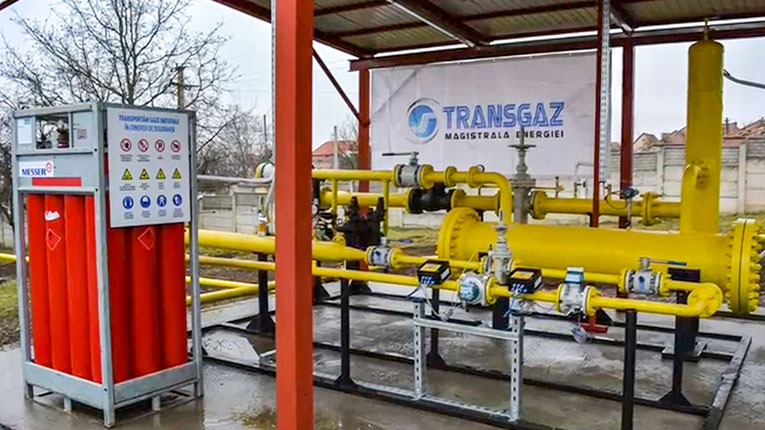A film made by Transgaz presents the first information about the company’s pilot project on hydrogen injection in natural gas transmission and distribution pipelines.
Within the pilot project called RO-HY Romania Hydrogen, the injection of hydrogen under laboratory conditions has already started. The concept design and execution phase was realized by Transgaz specialists and aims to determine the implications of transporting the natural gas and hydrogen blend for the NTS. The main objective of the project is to evaluate the effect of the gas blend on the performance under operating conditions of the main equipment and technical solutions used in the NTS. At the same time, the pilot installation can determine the impact of the natural gas and hydrogen blend on a gas distribution network up to the final consumer, including the reduction of greenhouse emissions by burning the natural gas and hydrogen blend. The experimental independent study aims to establish the percentage of hydrogen in the blend that can be safely transmitted through the current transmission infrastructure, the main vulnerabilities of the system in the context of using this blend, how to manage these vulnerabilities and implications that the addition of hydrogen has on the final consumers.
In order to minimize the risk of incidents occurring, the facilities used in the test are located outdoors. The experimental facility is located on a concrete platform protected by a metal cover. The experimental facility allows for hydrogen to be injected into the gas flow in a controlled manner and offers multiple possibilities for observing and recording the effects it has on the flow and the behaviour of the fluid, as well as the impact of the blend on the materials and equipment analyzed, including the facilities used and the environment. The configuration of the installation allows for different flow scenarios to be carried out which can be monitored through the gas measurement and analysis equipment. The modular construction allows for the interposing of various equipment that can thus be tested in real field testing conditions. The installation is provided with a test chamber that allows samples to be exposed to the conditions inside the installation. At the end of the exposure period information on the effect that the blending of natural gas and hydrogen has on them will be obtained by reference to the state of the control samples.
The necessary funds for carrying out the works, tests monitoring the behaviour over time and preparing the reports are provided in the 2021-2022 Transgaz research program. The data obtained will be the basis for setting up precise targets for the NTS against the background of the current policy on decarbonization at the European level and for the identification of the investments needed to achieve these targets, for adapting the current maintenance system and for developing a legislative and regulatory framework either by adapting the existing rules or by creating new rules without which the implementation of this technology cannot pass the testing stage.
“The development of research on the possibility of accepting the hydrogen blend into the NTS and ways of introducing it into the NTS as well as the retrofitting and upgrading of the existing natural gas transmission infrastructure for the use of hydrogen and other green gases are priority objectives” of the Transgaz management, is said in the movie.
In order to achieve the proposed objectives regarding the hydrogen injection into the natural gas transmission pipelines, the management of Transgaz selected some of the proposals to conclude at national level collaborations with third parties which can conduct research in the field or which will be involved in the use of hydrogen in the energy transition. It also set its own non-financial KPIs for 2021-2025, concluding a memorandum of cooperation and collaboration with European union gas transmission system operators on hydrogen injection collaboration.
